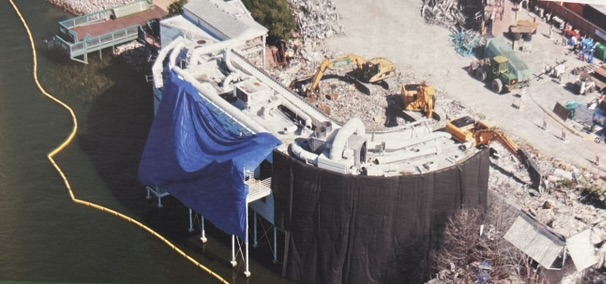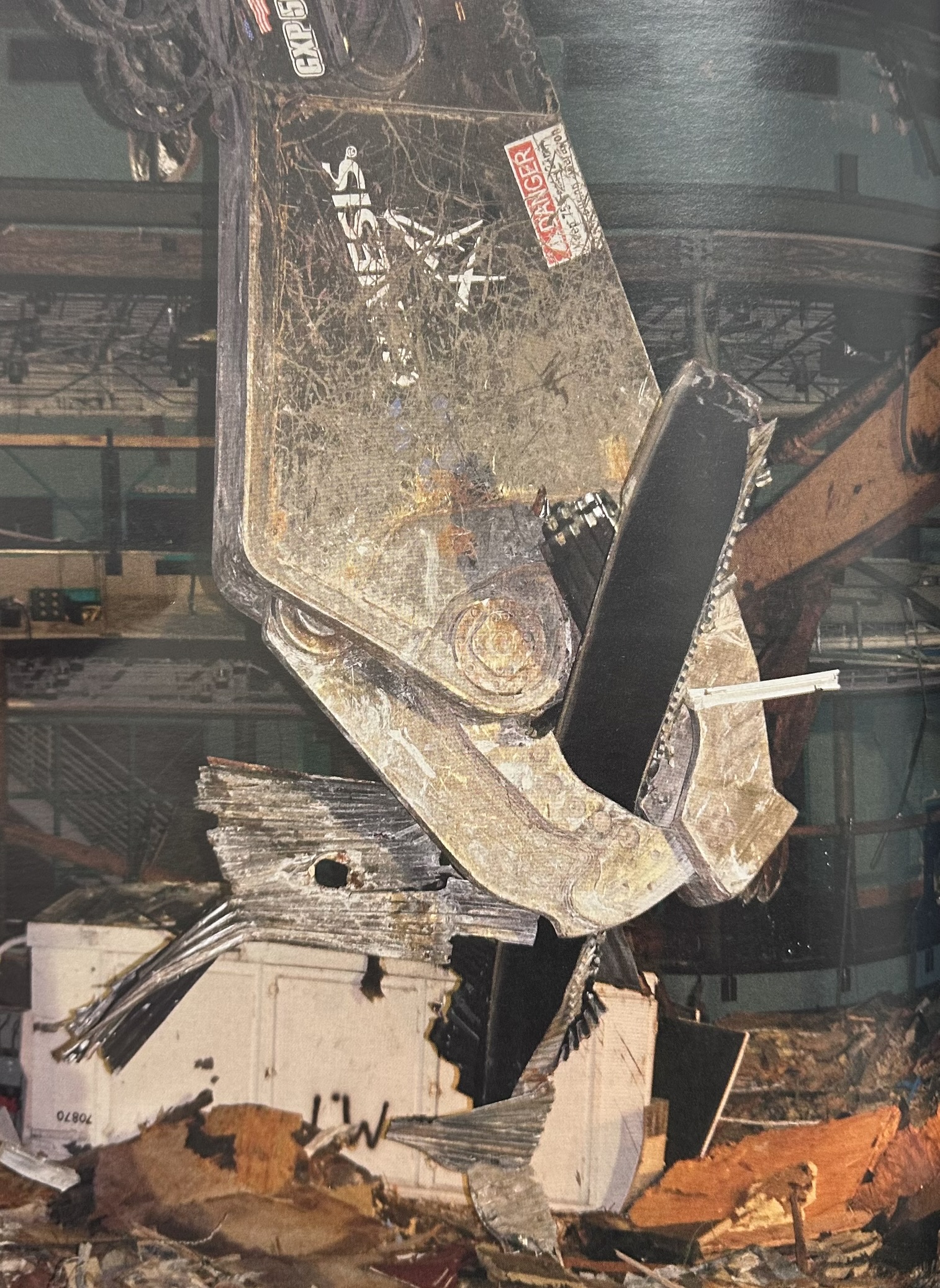‘Downtown’ Demo Opens Way for New Disney Development
July 29, 2025

This article originally appeared in the March/April 2011 issue of DEMOLITION magazine.
Call it a paradox for our times. A visit to any major Disney theme park, whether it is Florida’s Walt Disney World, Disneyland Paris or Hong Kong Disneyland, gives one the sense of belonging, a belief that everything is as it should be. Yet, if the Disney Company holds one tenet to heart, it is that its facilities should be in a constant state of flux.
Walt Disney himself said that: “Disneyland will never be completed. It will continue to grow as long as there is imagination left in the world.”
At the Downtown Disney areas of Orlando’s Walt Disney World complex, the demolition of Pleasure Island is proving that out. The once-popular nighttime destination is being leveled to make way for a newer, more family-friendly area called Hyperion Wharf. For the firm heading up the project, NDA member and Orlando-based Central Environmental Services Inc. (CES), the chance to play a role in that iconic park’s evolution has presented a host of challenges. However, armed with solid logistics and a Genesis GXP 500R mobile shear, the project is proving as rewarding as a ride on Space Mountain itself.
Pleasure Island is not old by any stretch of the imagination. Built in 1989 as an entertainment-based adjunct retail aspect of Downtown Disney, Pleasure Island featured seven nightclub-type venues that offered everything from comedy and improvisational theater to a full range of rock, hip-hop and Top 40 techno dance music. While reasonably successful, the area, and the sometimes overly boisterous patrons, proved a bit too much of a departure from the Walt Disney Company’s more traditional entertainment approach.
On Sept. 27, 2008, the entire Pleasure Island complex was closed, with little hint for what would replace it and when. Then, in November 2010, two important events occurred: Disney officials announced plans for Hyperion Wharf, a complex that will recall an early 20th-century port city amusement pier, complete with stylish boutiques and innovative restaurants, and concurrently awarded bids for demolition of many of the existing Pleasure Island structures.
According to Rich Lorenz, president and owner of demolition specialists CES, work they had previously done for general contractor Barton Malow provided something od an inside track to winning the PI bid.
“A few years back, we removed one of the bridges linking Pleasure Island with the rest of Downtown Disney,” he says. “It was a bit outdated in terms of being able to handle larger delivery vehicles, so, working only at night, when all the clubs and other facilities had closed, we cut it in half and flew it out. It was a good job but, just as importantly, we impressed Barton Malow with our capabilities.”

While helpful, that proven track record alone was not enough to secure the bid to demolish the first two structures at Pleasure Island. For that, Lorenz and CES had to further prove their expertise.
“Barton Malow and Disney wanted their demolition contractor, whoever it would be, to take down each structure, put the debris on a barge and take it to another area where it would be offloaded and hauled off for disposal. That was really contrary to the way we do things. So, while everyone else bid with Disney’s technique in mind, we came up with another plan.”
CES’s approach included laying down heavy-duty matting on the road leading into the demolition site. Doing so would allow them to move equipment and roll-off containers in and out without affecting any of the adjacent, non-demo areas.
“Then, at the end of each shift,” explains Lorenz, “we would pick up all the matting and store it until the next night’s work, pressure wash the pavement to remove any trace of our having been there, close the gate, and the surrounding area would be ready for the next day’s business. We understand that, to Disney, nothing is more important than their guests’ satisfaction.
From an economic standpoint, Lorenz says he knew their bid price would be tight, but he also knew the Pleasure Island site would be loaded with what he calls “jag,” all the copper, steel and other valuable items left behind when Disney shut the doors. “When they closed the area down, they took the high-end kitchen equipment but pretty much left everything else: the coolers, stainless sinks, cable, wiring and so on. That was our strategy and, as it turns out, it was a very good one. We won the bid for the first two structures, “Motion” and “Rock ‘n’ Roll Beach Club,” and each is yielding a very nice return on our scrap.”
The demolition itself is made more challenging by the fact that work can only be done between 2 a.m. and 8 a.m. To ensure the highest possible level of production, safety and control within that time frame, CES is using a GXP 500R mobile shear from Genesis Attachments, acquired through the Orlando office of U.S. Shoring & Equipment, the area Genesis dealer.
“Mind you, these are not small, prefab venues,” says Lorenz. “These are three-story structures, all metal, well-constructed. The Genesis shear enabled us to cut through everything we came into contact with and in a very controlled fashion. That was important because “Motion,” the first structure slated to come down, was attached to an existing restaurant called Portobello, which was still fully operational during normal business hours. So, we had to cut the three-story building away, weatherproof the restaurant and make certain that its business was not disturbed. We did it without a hitch; it was a perfect application of the shear.
Currently just past the project midpoint, Lorenz estimates they have salvaged more than 360 tons of steel, with a good deal still remaining. “We are using the Genesis shear to downsize the structural steel and other materials to prepared sizes, cut through rooftop air conditioning units, and even the steel signage is being processed with the shear,” he says.

Over the years, Lorenz says he and his company have learned how to dissect a building to make certain they maximize the debris value. “At Pleasure Island, for example, we are separating as we take a structure apart, then we take it to a laydown yard and separate it further. Eventually, it gets back to our Orlando facilities, where it is finally chopped, cleaned and separated into bins. We are a small outfit, but there is no one more committed to recycling than we are.”
Lorenz says they expect to be at the Pleasure Island site for approximately eight weeks, removing the two structures. After the demo is completed and the debris removed, they will begin pulling up the slabs and foundations, followed by 40-50 piles that have to be pulled to a minimum of 5 feet below grade.
“At that point, we are hoping that we will have won the bid to do the balance of the buildings at Pleasure Island. We are not out to be the biggest demolition contractor in central Florida. We just want to be the best and most compliant, and our safety record at the PI site says it all: We have gone 566 days without a lost-time accident; before that, it was 480 days. Safety is a huge concern for us, and the shear plays a big role in that as well. At one time, anything that we are shearing today had to be cut with a torch, and that can be a risky affair. There couldn’t have been a better tool made for demolition and scrap than the Genesis shear we’re using right now.”
Disney’s Hyperion Wharf is scheduled for a 2013 opening.